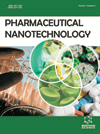
Full text loading...
We use cookies to track usage and preferences.I Understand
Paraquat (PQ) is an effective herbicide which is widely used around the world to remove weeds in agriculture. As a water-soluble carotenoid, crocin is a pharmacologically active constituent of C. sativus L. (saffron).
In the present study, we investigated the effects of crocin-loaded niosomes (Cro-NIO) compared to free crocin on PQ-induced toxicity in the eukaryotic human embryonic kidney (HEK293) cell line.
The Cro-NIO was synthesized and characterized. Cell viability was determined using the MTT assay in PQ-exposed HEK293 cell lines. The activities of biochemical markers were quantitatively determined to reveal the potential mechanism of PQ-induced oxidative stress in HEK293 cell line.
The particle size, zeta potential, polydispersity index (PDI), DL, and EE of Cro-NIO were 145.4 ± 19.5 nm, -22.3 ± 3.11 mV, 0.3 ± 0.03, 1.74 ± 0.01%, and 55.3 ± 7.1%, respectively. PQ-treated HEK293 cell lines decreased cell viability. The results of oxidative status showed that PQ significantly could increase ROS accumulation, accompanied by a decreasing antioxidant defense system. However, treatment with Cro-NIO, compared to crocin, not only did dose-dependently improve the cell viability but also significantly attenuated the ROS accumulation and increased antioxidant markers.
According to these results, Cro-NIO, compared to crocin, was superior to ameliorating PQ-induced cytotoxicity and oxidative damage in HEK293 cells.

Article metrics loading...

Full text loading...
References


Data & Media loading...

